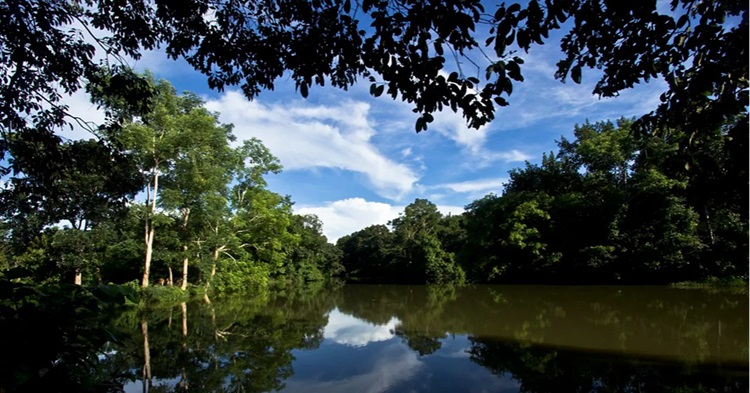Rema–Kalenga Wildlife Sanctuary in Habiganj: A Comprehensive Travel Guide


Beyond the hum-drum of hectic cities, Bangladesh is home to several wildlife sanctuaries that conserve endangered species, maintain ecological balance, and offer natural habitats for wildlife and migratory birds. The Habiganj district, located in the northeastern part of Bangladesh, is blessed with natural greenery, featuring lush forests, tea gardens, hills, and wildlife. Rema-Kalenga Wildlife Sanctuary was created in 1982 in Habiganj and was enlarged in 1996. Besides abounding in many rare plants and animal species, its scenic landscapes provide fresh air, biodiversity, and a peaceful environment for visitors and locals. Here is a detailed travel guide to Rema-Kalenga Wildlife Sanctuary.
Location
The Rema–Kalenga Wildlife Sanctuary is located at Chunarughat Upazila of Habiganj District in the Sylhet Division. It lies next to India's Tripura border and close to Srimangal in the Moulvibazar district. Approximately 130 km northeast of Dhaka, the city, lies the wildlife reserve. It includes the Kalenga, Rema, Chanbari, and Rashidpur portions of the Habiganj District's Kalenga Forest Range.
Significance
The Rema–Kalenga Wildlife Sanctuary is a protected forest and wildlife reserve in Bangladesh. It is a dry and evergreen forest, and after the Sundarbans, it is the largest natural forest in Bangladesh. It is also the country’s second-largest wildlife sanctuary and one of the richest areas in terms of biodiversity. The sanctuary covers an area of 1,795.54 hectares. Among the few natural forests in Bangladesh that have survived in relatively good condition, Rema–Kalenga is one of the most notable.
Among Bangladesh's natural forests, this sanctuary is still in good condition. However, the refuge is threatened by deforestation and careless tree theft.
Flora
The sanctuary is home to 638 species of plants, trees, and vines. Some of the most notable among them include Awal, Teak, Kakra, Neur, Hargaza, Gandharoi, Haritaki, Bohera, Jamun, Fig, Jackfruit, Champa Jackfruit, Kau, Kadam, Rata, Chikrashi, Chapalish, Neem, Bonmala, etc.
Fauna
The forest is also home to about seven species of amphibians, eighteen species of reptiles, and one hundred sixty-seven species of birds. Noteworthy birds include the Greater Racket-tailed Drongo, Hill Myna, Asian Pied Hornbill, Junglefowl, Spotted Dove, Magpie Robin, Common Myna, Spotted Owlet, and Tailorbird. BirdLife International has lauded the sanctuary as an Important Bird Area (IBA).
In addition, there are 37 species of mammals. Among them are wild boar (both black and white), monkeys, langurs, capped langurs, hares, barking deer, fishing cats, civets, wild dogs, and jackals.
The hog badger, wild boar, barking deer, Indian leopard, Asian golden cat, leopard cat, western hoolock gibbon, capped langur, and Phayre's langur are some of the more noteworthy animals that may be found here. There are five squirrel species. Burmese pythons, green pit vipers, and other snakes and lizards are among the reptiles.
Though locals claim that tigers and leopards were widespread in the 1960s, no confirmed tiger sightings have been reported since 1971. Leopard sightings are reported from time to time. However, they might be strays from the nearby Indian forest. Locally, the dhole has been extinct since the 1990s. The primary terrestrial predators of this forest are jackals and small wildcats.
What to See and Do
Upon entering the forest, visitors are spellbound by lush greenery. The Rema–Kalenga Wildlife Sanctuary offers three nature trails of half an hour, one hour, and three hours in length. Each is beautifully designed, resembling a picture-perfect path.
With some luck, visitors may spot a variety of birds and animals, creating an atmosphere that feels like a completely different world in the Rema-Kalenga Wildlife Sanctuary.
Inside the sanctuary stands a tall watchtower that rises above the treetops. It offers expansive views of the distant forest landscape. Visitors can climb and enjoy a panoramic view of the forest. As far as the eye can see, one will find only dense jungle.
At the foot of the tower lies a winding lake. Its surroundings appear so natural that it is difficult to believe it is man-made. The lake was created to provide water for wild birds and animals.
The lifestyles of indigenous communities can also be observed here. Four indigenous groups live within the Rema–Kalenga forest. Several Tripura villages are located inside the forest, along with settlements of the Santal, Telugu, and Urang communities.
Best time to visit
You can visit the Rema-Kalenga Wildlife Sanctuary throughout the year. However, during the monsoon season, the trails become muddy, making walking more difficult.
How to get there
Via Shayestaganj
To reach the Rema-Kalenga Wildlife Sanctuary from Dhaka, you can take a Sylhet-bound bus or train and get off at Shayestaganj. Regular bus fares from Dhaka to Shayestaganj range from Tk 250 to 300.
The Upaban Express intercity train to Sylhet also stops at Shayestaganj. Except on Wednesdays, it departs Dhaka every night at 10:00 pm. Train fares range from Tk 120 to 673.
From Shayestaganj, take local transport like an autorickshaw or a baby taxi to arrive at Kalenga. The costs may be around Tk 500 to 600.
Via Srimangal
Another route to Kalenga is via Srimangal, either by bus or train from Dhaka. Buses on the Dhaka to Srimangal route are available from Dhaka’s Fakirapul and Saidabad terminals. Fares range from Tk 350 to 450. You can take trains from Kamalapur Railway Station in Dhaka.
From Srimangal, visitors can hire a jeep to Kalenga. The costs range from Tk 2,000 to 3,000. This route offers a longer journey through the forest, which many find enjoyable. However, travel by jeep through the forest may be difficult during the rainy season.
Where to stay
Kalenga has a Forest Department rest house, but staying there requires permission from the Sylhet Divisional Forest Officer.
Nishorgo Taraf Hill Cottage is a popular staycation for tourists. Besides these, in Habiganj town, visitors can stay at local hotels, where room rates range from Tk 800 to 2,500.
Alternatively, the five-star Palace Resort in Bahubal Upazila offers luxury accommodation, with rates between Tk 7,000 and 15,000.
Cautions
It is recommended to take a guide when exploring Rema–Kalenga. therefore, to ensure safe and responsible travel, it would be wise to avoid travelling in this forest during the monsoon season in pursuit of adventure.
